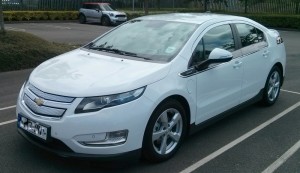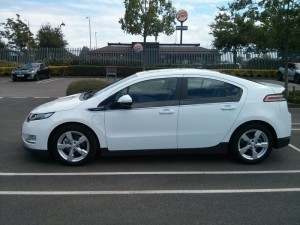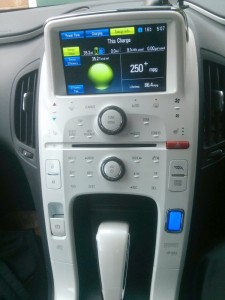As a child growing up in the 1970s, I had no idea of what the future held. I didn’t know if Mr Benn would be able to get back from his adventures, or if Scooby Doo could catch the Evil Swamp Monster, or even if we were going through the round or square window in PlaySchool. But there were some things about the future that was pretty certain. We would all have robot butlers, go on holiday to the moon and drive electric cars!
So, as I drove to work this morning in my electric car, wondering when my moon tickets would drop through the letterbox, I realised that maybe, just maybe, I am already in the future
The car itself is a 2013 Chevrolet Volt Extended Range Electric Vehicle (E-REV). There is quite a large choice of electric vehicle on the roads in the UK right now, and, just like petrol cars, come in a range of sizes, styles and prices to suit different people. They don’t all work the same way, or use the same technology, and what may be perfect for one person might not work at all well for someone else. For example, a Nissan Leaf is battery only, quick to charge but only has a range of 80 miles or so. Hybrids like the Toyota Prius, have a engine and a motor and can run on either and will charge the battery when running on petrol.
I have covered almost 2500 miles in just over 2 months, and most people I talk to seem interested in how it works both technically and practically for me, and why I went for this kind of car. It is an excellent car that suits me well, but it does have limitations and downsides that mean it might not be for everyone.
Firstly, it is an Extended Range Electric Vehicle. That is, it runs on an electric motor from battery power, but it also has a petrol engine that can run a generator to keep the battery from running flat. Unlike a hybrid, the petrol engine does not drive the car. Normally, the battery is charged up from home which gives me range of about 40-50 miles before the engine needs to kick in. As my daily commute is around 18 miles each way, and I’ve not been on any long journeys since getting the car, the engine has not been needed, or even started.
(Except once. I got in the car and a message on the dashboard informed me that due to the infrequent use of the engine it needs to be run for a 10 minute maintenance schedule. I guess that makes sense to ensure nothing seizes and all the fluids are pumped around a bit. And 10 mins of petrol use over 2500 miles (so far) still seems very low!)
Charging the car is very easy. It comes with an adapter that will plug in to any UK 13A plug socket. This runs at 6A by default and will fully charge the battery from flat in around 8 hours. It can be overridden to run at 10A, or 6 hours to charge. Thanks to a government scheme though, I have had a dedicated charge point fitted free, and this runs at 16A, taking about 4 hours to fully charge.
There are electric charge points dotted around all over the place, most of which are free, some are cheap and others less so. These range from most IKEA branches, some supermarkets, city car parks, motorway services, hotels and other places. They are often run by different companies and have one or more of the common 4 charging sockets and charge at different rates of power. Although I have free access cards for a couple of companies charging posts, so far I have not used (or needed) any.
Some other electric vehicles, particularly the battery only ones have much more powerful charges built in to them, so can charge at 32A, 63A or 125A. This makes sense for en-route charging if you need to drive somewhere beyond the limit of your battery. The Chevrolet Volt, though, takes too long to charge for this to be practical. Effectively, you get a maximum of about 12 miles range per hour of charge, which makes it suitable for destination charging. Unless, of course, I wanted to stop for 4 hours every 40-50 miles!
As I said earlier, though, my daily commute is about 36 miles round trip, so that has been covered on battery only since getting the car. Some evenings I pop out, and some weekends I take much longer trips. So far, plugging in when I get home for an hour or so has covered all the evening trips, but sooner or later I will be heading down to Essex or further afield. For a trip like this, the first 40+ miles will be purely electric, with the remainder of the journey having the engine running.
As you can imagine, the engine is a small efficient unit. Because it is not driving the car, the speed it runs at is controlled for efficiency of charging, and I can expect to get over 50mpg from it. Still not too shabby for a big car like this.
So, how much does it cost to run then? Well, I’m glad you asked. It has worked out around 3.4p per mile based on the cost of electricity to charge it up. That is around £1.25 per day to commute to work and back. By comparison, the same journey in my LPG PT Cruiser (which wasn’t too efficient, but the fuel was cheap) cost around £7 per day. If I’d been running that car on petrol, it would have been over £13. Then, of course, there’s the car tax which is zero! And, because of less engine wear and less break usage (regenerative breaking used whenever possible) services costs are lower too.
But I bet it is slow. What is it like to drive? Actually, it’s quick. Amazingly quick. I mean, really quick. Even in “normal” mode, it takes off from the lights quicker than most cars out there, and in “sport” mode, it can outpace a rocket! And, unlike a convention engine that has a gearbox to make use of its sweet spot of power, an electric motor has torque available to it whatever the speed. And with the exception of a little bit of tyre noise and wind noise at higher speed, it is completely silent! It is so quiet actually, that I am beginning to listen to the background noises and interference in most of the pod casts I listen to!
Oh, and don’t get me started on gadgets. Well, ok, yes, it has gadgets. Lots of them. Sure, regular stuff like CD \ DVD player, electrically heated seats, sat nav, Bluetooth etc. But also touch screen display, DAB radio, rear view reversing camera, hard drive for MP3s. My favourite one, however, is preconditioning; Before you leave in the morning, whilst the car is still plugged in, the heaters and window demist can be triggered. So, not only do you come out of the house to a nice warm car (or a cool car in the summer), but it doesn’t affect the electric range as this was done from the mains supply! Genius!
Despite the fact that electric cars have been around for years (If the Toyota Prius was human, it would be getting its GCSE results next year!), things have still got a long way to go before everyone drives an electric vehicle. The infrastructure isn’t yet as commonplace as it needs to be. The range of all cars except the Tesla S will mean compromises for most people. Initial purchase price is still too high compared to a dinosaur fuelled equivalent.
But, one by one, we will all get to the future. For me personally, I am really pleased that I am living in the future already, although just a little bit sad that my robot butler must have hidden my moon tickets!



